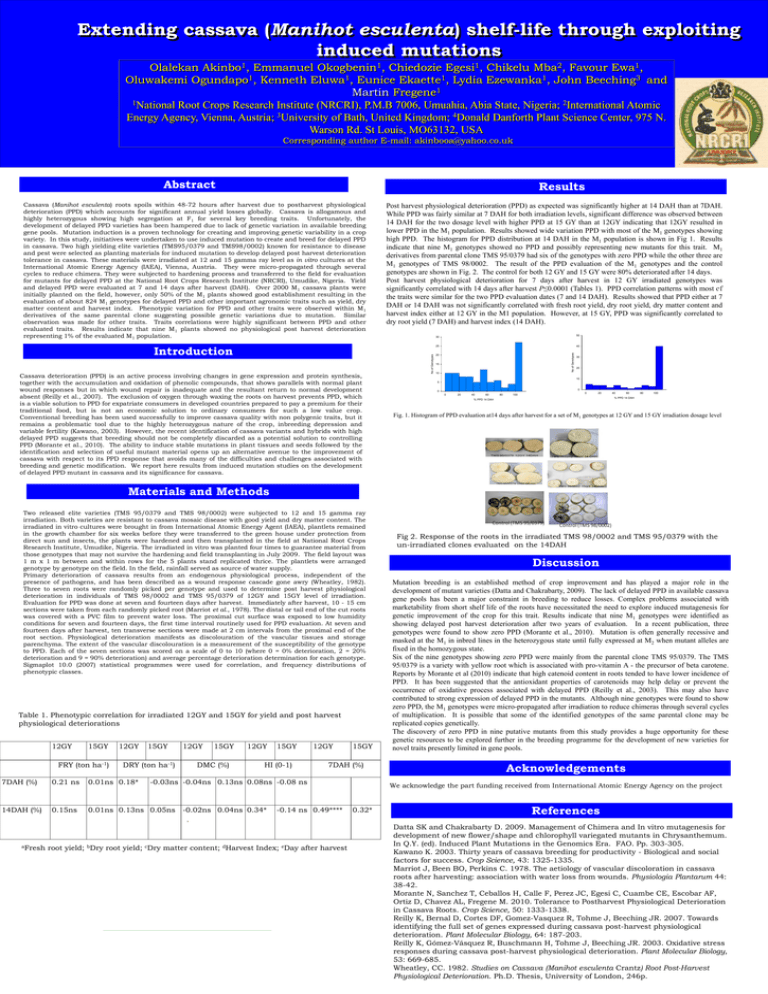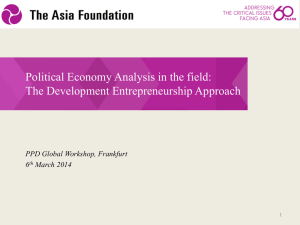Extending Cassava shelf-life through exploring Induced Mutations
advertisement

Extending cassava (Manihot esculenta) shelf-life through exploiting induced mutations Olalekan Akinbo1, Emmanuel Okogbenin1, Chiedozie Egesi1, Chikelu Mba2, Favour Ewa1, Oluwakemi Ogundapo1, Kenneth Eluwa1, Eunice Ekaette1, Lydia Ezewanka1, John Beeching3 and Martin Fregene1 1National Root Crops Research Institute (NRCRI), P.M.B 7006, Umuahia, Abia State, Nigeria; 2International Atomic Energy Agency, Vienna, Austria; 3University of Bath, United Kingdom; 4Donald Danforth Plant Science Center, 975 N. Warson Rd. St Louis, MO63132, USA Corresponding author E-mail: akinbooa@yahoo.co.uk Abstract A Cassava (Manihot esculenta) roots spoils within 48-72 hours after harvest due to postharvest physiological deterioration (PPD) which accounts for significant annual yield losses globally. Cassava is allogamous and highly heterozygous showing high segregation at F1 for several key breeding traits. Unfortunately, the development of delayed PPD varieties has been hampered due to lack of genetic variation in available breeding gene pools. Mutation induction is a proven technology for creating and improving genetic variability in a crop variety. In this study, initiatives were undertaken to use induced mutation to create and breed for delayed PPD in cassava. Two high yielding elite varieties (TMS95/0379 and TMS98/0002) known for resistance to disease and pest were selected as planting materials for induced mutation to develop delayed post harvest deterioration tolerance in cassava. These materials were irradiated at 12 and 15 gamma ray level as in vitro cultures at the International Atomic Energy Agency (IAEA), Vienna, Austria. They were micro-propagated through several cycles to reduce chimera. They were subjected to hardening process and transferred to the field for evaluation for mutants for delayed PPD at the National Root Crops Research Institute (NRCRI), Umudike, Nigeria. Yield and delayed PPD were evaluated at 7 and 14 days after harvest (DAH). Over 2000 M1 cassava plants were initially planted on the field, however, only 50% of the M1 plants showed good establishment resulting in the evaluation of about 824 M1 genotypes for delayed PPD and other important agronomic traits such as yield, dry matter content and harvest index. Phenotypic variation for PPD and other traits were observed within M1 derivatives of the same parental clone suggesting possible genetic variations due to mutation. Similar observation was made for other traits. Traits correlations were highly significant between PPD and other evaluated traits. Results indicate that nine M1 plants showed no physiological post harvest deterioration representing 1% of the evaluated M1 population. Introduction Results Post harvest physiological deterioration (PPD) as expected was significantly higher at 14 DAH than at 7DAH. While PPD was fairly similar at 7 DAH for both irradiation levels, significant difference was observed between 14 DAH for the two dosage level with higher PPD at 15 GY than at 12GY indicating that 12GY resulted in lower PPD in the M1 population. Results showed wide variation PPD with most of the M1 genotypes showing high PPD. The histogram for PPD distribution at 14 DAH in the M1 population is shown in Fig 1. Results indicate that nine M1 genotypes showed no PPD and possibly representing new mutants for this trait. M1 derivatives from parental clone TMS 95/0379 had six of the genotypes with zero PPD while the other three are M1 genotypes of TMS 98/0002. The result of the PPD evaluation of the M1 genotypes and the control genotypes are shown in Fig. 2. The control for both 12 GY and 15 GY were 80% deteriorated after 14 days. Post harvest physiological deterioration for 7 days after harvest in 12 GY irradiated genotypes was B significantly correlated with 14 days after harvest P≤0.0001 (Tables 1). PPD correlation patterns with most of C the traits were similar for the two PPD evaluation dates (7 and 14 DAH). Results showed that PPD either at 7 DAH or 14 DAH was not significantly correlated with fresh root yield, dry root yield, dry matter content and harvest index either at 12 GY in the M1 population. However, at 15 GY, PPD was significantly correlated to dry root yield (7 DAH) and harvest index (14 DAH). 50 30 Cassava deterioration (PPD) is an active process involving changes in gene expression and protein synthesis, together with the accumulation and oxidation of phenolic compounds, that shows parallels with normal plant wound responses but in which wound repair is inadequate and the resultant return to normal development absent (Reilly et al., 2007). The exclusion of oxygen through waxing the roots on harvest prevents PPD, which is a viable solution to PPD for expatriate consumers in developed countries prepared to pay a premium for their traditional food, but is not an economic solution to ordinary consumers for such a low value crop. Conventional breeding has been used successfully to improve cassava quality with non polygenic traits, but it remains a problematic tool due to the highly heterozygous nature of the crop, inbreeding depression and variable fertility (Kawano, 2003). However, the recent identification of cassava variants and hybrids with high delayed PPD suggests that breeding should not be completely discarded as a potential solution to controlling PPD (Morante et al., 2010). The ability to induce stable mutations in plant tissues and seeds followed by the identification and selection of useful mutant material opens up an alternative avenue to the improvement of cassava with respect to its PPD response that avoids many of the difficulties and challenges associated with breeding and genetic modification. We report here results from induced mutation studies on the development of delayed PPD mutant in cassava and its significance for cassava. 40 No of Genotypes No of Genotypes 25 20 15 10 30 20 10 5 0 0 0 20 40 60 80 100 0 20 40 60 80 100 % PPD 14 DAH % PPD 14 DAH Fig. 1. Histogram of PPD evaluation at14 days after harvest for a set of M1 genotypes at 12 GY and 15 GY irradiation dosage level Materials and Methods Two released elite varieties (TMS 95/0379 and TMS 98/0002) were subjected to 12 and 15 gamma ray irradiation. Both varieties are resistant to cassava mosaic disease with good yield and dry matter content. The irradiated in vitro cultures were brought in from International Atomic Energy Agent (IAEA), plantlets remained in the growth chamber for six weeks before they were transferred to the green house under protection from direct sun and insects, the plants were hardened and then transplanted in the field at National Root Crops Research Institute, Umudike, Nigeria. The irradiated in vitro was planted four times to guarantee material from those genotypes that may not survive the hardening and field transplanting in July 2009. The field layout was 1 m x 1 m between and within rows for the 5 plants stand replicated thrice. The plantlets were arranged genotype by genotype on the field. In the field, rainfall served as source of water supply. Primary deterioration of cassava results from an endogenous physiological process, independent of the presence of pathogens, and has been described as a wound response cascade gone awry (Wheatley, 1982). Three to seven roots were randomly picked per genotype and used to determine post harvest physiological deterioration in individuals of TMS 98/0002 and TMS 95/0379 of 12GY and 15GY level of irradiation. Evaluation for PPD was done at seven and fourteen days after harvest. Immediately after harvest, 10 - 15 cm sections were taken from each randomly picked root (Marriot et al., 1978). The distal or tail end of the cut roots was covered with a PVC film to prevent water loss. The proximal cut surface was exposed to low humidity conditions for seven and fourteen days, the first time interval routinely used for PPD evaluation. At seven and fourteen days after harvest, ten transverse sections were made at 2 cm intervals from the proximal end of the root section. Physiological deterioration manifests as discolouration of the vascular tissues and storage parenchyma. The extent of the vascular discolouration is a measurement of the susceptibility of the genotype to PPD. Each of the seven sections was scored on a scale of 0 to 10 (where 0 = 0% deterioration, 2 = 20% deterioration and 9 = 90% deterioration) and average percentage deterioration determination for each genotype. Sigmaplot 10.0 (2007) statistical programmes were used for correlation, and frequency distributions of phenotypic classes. Table 1. Phenotypic correlation for irradiated 12GY and 15GY for yield and post harvest physiological deteriorations 12GY 15GY FRY (ton ha-1) 12GY 15GY DRY (ton ha-1) 12GY 15GY DMC (%) 12GY HI (0-1) 7DAH (%) 0.21 ns 0.01ns 0.18* 14DAH (%) 0.15ns 0.01ns 0.13ns 0.05ns -0.02ns 0.04ns 0.34* aFresh 15GY 12GY 15GY 7DAH (%) -0.03ns -0.04ns 0.13ns 0.08ns -0.08 ns -0.14 ns 0.49**** root yield; bDry root yield; cDry matter content; dHarvest Index; eDay after harvest Fig 2. Response of the roots in the irradiated TMS 98/0002 and TMS 95/0379 with the un-irradiated clones evaluated on the 14DAH Discussion Mutation breeding is an established method of crop improvement and has played a major role in the development of mutant varieties (Datta and Chakrabarty, 2009). The lack of delayed PPD in available cassava gene pools has been a major constraint in breeding to reduce losses. Complex problems associated with marketability from short shelf life of the roots have necessitated the need to explore induced mutagenesis for genetic improvement of the crop for this trait. Results indicate that nine M1 genotypes were identified as showing delayed post harvest deterioration after two years of evaluation. In a recent publication, three genotypes were found to show zero PPD (Morante et al., 2010). Mutation is often generally recessive and masked at the M1 in inbred lines in the heterozygous state until fully expressed at M2 when mutant alleles are fixed in the homozygous state. Six of the nine genotypes showing zero PPD were mainly from the parental clone TMS 95/0379. The TMS 95/0379 is a variety with yellow root which is associated with pro-vitamin A - the precursor of beta carotene. Reports by Morante et al (2010) indicate that high catenoid content in roots tended to have lower incidence of PPD. It has been suggested that the antioxidant properties of carotenoids may help delay or prevent the occurrence of oxidative process associated with delayed PPD (Reilly et al., 2003). This may also have contributed to strong expression of delayed PPD in the mutants. Although nine genotypes were found to show zero PPD, the M1 genotypes were micro-propagated after irradiation to reduce chimeras through several cycles of multiplication. It is possible that some of the identified genotypes of the same parental clone may be replicated copies genetically. The discovery of zero PPD in nine putative mutants from this study provides a huge opportunity for these genetic resources to be explored further in the breeding programme for the development of new varieties for novel traits presently limited in gene pools. Acknowledgements We acknowledge the part funding received from International Atomic Energy Agency on the project 0.32* References Datta SK and Chakrabarty D. 2009. Management of Chimera and In vitro mutagenesis for development of new flower/shape and chlorophyll variegated mutants in Chrysanthemum. In Q.Y. (ed). Induced Plant Mutations in the Genomics Era. FAO. Pp. 303-305. Kawano K. 2003. Thirty years of cassava breeding for productivity - Biological and social factors for success. Crop Science, 43: 1325-1335. Marriot J, Been BO, Perkins C. 1978. The aetiology of vascular discoloration in cassava roots after harvesting: association with water loss from wounds. Physiologia Plantarum 44: 38-42. Morante N, Sanchez T, Ceballos H, Calle F, Perez JC, Egesi C, Cuambe CE, Escobar AF, Ortiz D, Chavez AL, Fregene M. 2010. Tolerance to Postharvest Physiological Deterioration in Cassava Roots. Crop Science, 50: 1333-1338. Reilly K, Bernal D, Cortes DF, Gomez-Vasquez R, Tohme J, Beeching JR. 2007. Towards identifying the full set of genes expressed during cassava post-harvest physiological deterioration. Plant Molecular Biology, 64: 187-203. Reilly K, Gómez-Vásquez R, Buschmann H, Tohme J, Beeching JR. 2003. Oxidative stress responses during cassava post-harvest physiological deterioration. Plant Molecular Biology, 53: 669-685. Wheatley, CC. 1982. Studies on Cassava (Manihot esculenta Crantz) Root Post-Harvest Physiological Deterioration. Ph.D. Thesis, University of London, 246p.








